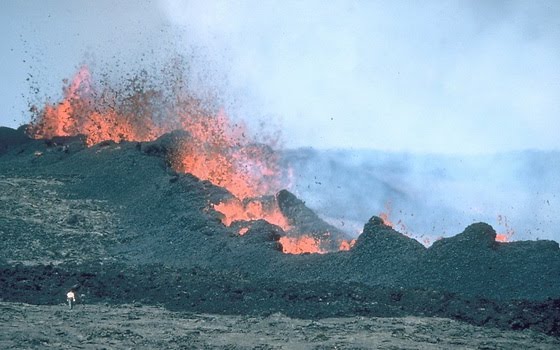 Mauna Loa is the largest volcano on Earth in terms of volume and area covered and one of five volcanoes that form the Island of Hawaii in the U.S. state of Hawaii in the Pacific Ocean. It is an active shield volcano, with a volume estimated at approximately 18,000 cubic miles (75,000 km3), although its peak is about 120 feet (37 m) lower than that of its neighbor, Mauna Kea. The Hawaiian name "Mauna Loa" means "Long Mountain". Lava eruptions from Mauna Loa are silica-poor, thus very fluid: and as a result eruptions tend to be non-explosive and the volcano has relatively shallow slopes.
Mauna Loa is the largest volcano on Earth in terms of volume and area covered and one of five volcanoes that form the Island of Hawaii in the U.S. state of Hawaii in the Pacific Ocean. It is an active shield volcano, with a volume estimated at approximately 18,000 cubic miles (75,000 km3), although its peak is about 120 feet (37 m) lower than that of its neighbor, Mauna Kea. The Hawaiian name "Mauna Loa" means "Long Mountain". Lava eruptions from Mauna Loa are silica-poor, thus very fluid: and as a result eruptions tend to be non-explosive and the volcano has relatively shallow slopes.
 The volcano has probably been erupting for at least 700,000 years and may have emerged above sea level about 400,000 years ago, although the oldest-known dated rocks do not extend beyond 200,000 years. Its magma comes from the Hawaii hotspot, which has been responsible for the creation of the Hawaiian island chain for tens of millions of years. The slow drift of the Pacific Plate will eventually carry the volcano away from the hotspot, and the volcano will then become extinct within 500,000 to one million years from now.
The volcano has probably been erupting for at least 700,000 years and may have emerged above sea level about 400,000 years ago, although the oldest-known dated rocks do not extend beyond 200,000 years. Its magma comes from the Hawaii hotspot, which has been responsible for the creation of the Hawaiian island chain for tens of millions of years. The slow drift of the Pacific Plate will eventually carry the volcano away from the hotspot, and the volcano will then become extinct within 500,000 to one million years from now.
Mauna Loa's most recent eruption occurred from March 24, 1984, to April 15, 1984. No recent eruptions of the volcano have caused fatalities, but eruptions in 1926 and 1950 destroyed villages, and the city of Hilo is partly built on lava flows from the late nineteenth century. In view of the hazards it poses to population centers, Mauna Loa is part of the Decade Volcanoes program, which encourages studies of the most dangerous volcanoes. Mauna Loa has been intensively monitored by the Hawaiian Volcano Observatory since 1912. Observations of the atmosphere are undertaken at the Mauna Loa Observatory, and of the Sun at the Mauna Loa Solar Observatory, both located near its summit. Hawaii Volcanoes National Park covers the summit and the southeastern flank of the volcano, including a separate volcano, Kīlauea.
Source
Jan 10, 2010
The Largest Volcano on Earth - Mauna Loa (Hawaii)
1/10/2010
Nature















